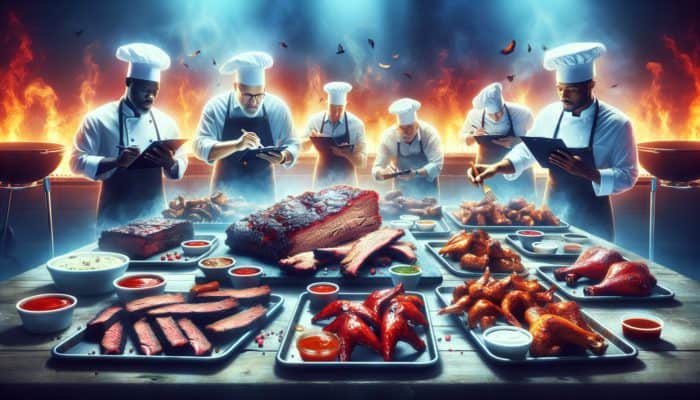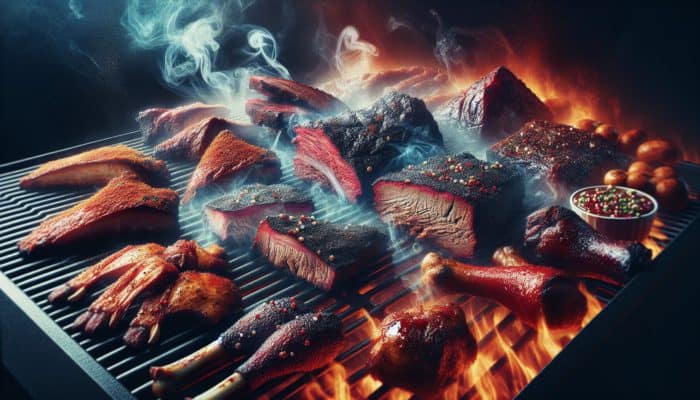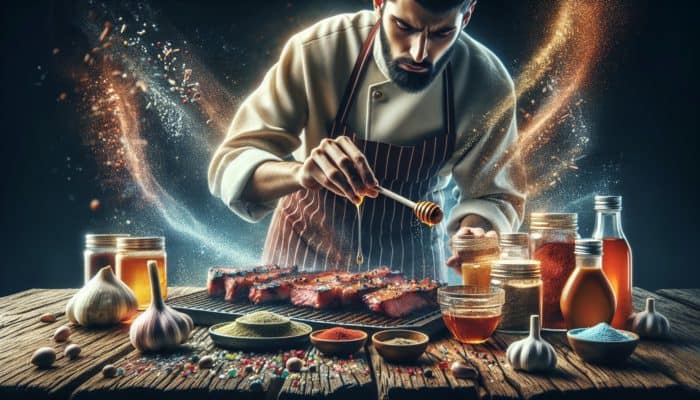Essential Techniques for Choosing High-Quality Meats for Your BBQ Competition Menu
Creating a standout BBQ competition menu involves more than just personal taste; it requires a deep understanding of the specific qualities that judges look for in each dish. At the core of BBQ competitions is the careful selection of meats. Each type, such as beef, pork, and chicken, possesses distinctive traits and judging criteria. It’s essential to align with popular preferences while simultaneously offering exceptional selections that will impress knowledgeable judges.
Understanding Your Meat Options: Beef, Pork, or Chicken for BBQ Success

In the dynamic arena of BBQ competitions across the United States, beef, pork, and chicken each offer unique flavor profiles and textures that distinguish them from one another. Judges evaluate fundamental aspects such as tenderness, flavor, and presentation of the meat; thus, choosing the right cuts that excel in these categories is critical. For example, beef brisket is highly favored due to its robust flavor and remarkable ability to absorb smoky flavors. In contrast, pork ribs are judged based on their ability to cling to the bone and the perfect balance of sweetness in the sauce. Chicken, particularly cuts like thighs and wings, provides room for creativity with inventive marinades or rubs that can significantly enhance the dish.
Each type of meat calls for a customized approach, not only in its preparation but also in its presentation. For instance, cooking brisket requires a low and slow method to effectively render the fat, resulting in a tender bite that judges will certainly admire. In contrast, chicken demands careful monitoring to avoid drying out, particularly with high-heat cooking methods that can quickly strip the meat of its moisture.
Discovering Premium Cuts for Outstanding BBQ Competition Performance
The caliber of your meat is crucial in creating a BBQ competition menu that stands out amidst stiff competition. Sourcing your cuts from trustworthy suppliers guarantees that you receive meat that is fresh, flavorful, and well-marbled. Marbling, the intramuscular fat that enhances flavor and tenderness, is a vital aspect to consider. Building strong connections with local butchers or farmers can provide access to top-notch cuts, an indispensable factor for competition-grade BBQ.
Furthermore, being knowledgeable about various meat grades, such as USDA Choice or Prime, can significantly impact the quality of your dishes. Although prime cuts may come at a higher cost, they generally deliver outstanding results in terms of texture and flavor. Visiting local farmers’ markets or specialty meat shops can also lead to exciting finds of unique, high-quality cuts tailored for BBQ enthusiasts.
Access Engaging Audio Insights for Deeper Learning!
Fine-Tuning Cooking Techniques for Exceptional BBQ Outcomes
Each cooking method—whether smoking, grilling, or slow cooking—presents its own unique challenges and opportunities for enhancing flavor. Mastering the specific techniques associated with each method is essential for achieving the best results in your BBQ dishes. For instance, smoking is often hailed as the pinnacle of BBQ, demanding exact timing and temperature control to achieve perfection. Prepping meats with rubs or marinades in advance allows flavors to penetrate deeply, enriching the final dish.
On the flip side, grilling typically involves quick, high-heat methods that require precise timing to avoid overcooking. Different cuts of meat may call for varied approaches; tougher cuts often benefit from an overnight marinade, while more delicate meats like chicken can be ready for grilling after a brief soak in a flavorful marinade.
Ultimately, mastering the preparation of various meats for different cooking styles empowers you to maximize flavor and tenderness, both of which are essential elements in ensuring your entries shine in a competitive setting.
Enhancing Flavor with Expertly Crafted Rubs and Marinades for BBQ Mastery

Creating an outstanding BBQ competition menu goes far beyond merely picking the right cuts of meat; the artful use of rubs and marinades is pivotal in elevating flavors and achieving mouthwatering results. Mastery of these elements can differentiate your dishes from the competition, leaving an unforgettable mark on even the most discerning judges.
Designing Your Signature Rubs for Unmatched BBQ Excellence
Your signature rub can serve as the transformative factor that elevates an ordinary BBQ dish into an extraordinary culinary experience. Crafting unique blends of spices and herbs is an art form, and understanding how each flavor interacts with the meat is essential. A well-designed rub should enhance the meat’s natural flavors without overpowering them, allowing the inherent qualities to shine through.
Consider balancing sweet and savory elements when developing your rubs. For instance, a blend of brown sugar, paprika, and garlic powder can create a base that caramelizes beautifully during cooking. Meanwhile, a dash of cayenne or black pepper adds just the right amount of heat. Experimentation is key; do not hesitate to explore various spice combinations to discover that perfect blend that reflects your unique style.
Moreover, it’s essential to apply the rub generously and allow it to rest for several hours or even overnight. This resting period enables flavor integration into the meat, resulting in a harmonious taste that can truly captivate judges.
Perfecting Marinade Recipes for Ultimate Flavor Infusion
Marinades not only impart flavor but also serve to tenderize the meat and retain moisture throughout the cooking process. Crafting the ideal marinade requires a careful balance of acidity, oil, and spices. For example, a marinade based on vinegar or citrus can effectively break down tough fibers, yielding a more tender bite.
It is crucial to consider marination time based on the specific cut of meat. While chicken can benefit from a short soak of about 30 minutes to an hour, tougher cuts like brisket may require an overnight marinade for optimal flavor penetration and tenderness. This is where the dynamics of BBQ truly shine, as one marinade can yield vastly different outcomes depending on the meat being used.
When designing your marinade recipes, focus on the overall flavor profile you wish to achieve. For example, a sweet and tangy marinade might beautifully complement pork, while a savory, herbaceous marinade could be ideal for chicken. By understanding the characteristics of each type of meat, you can create marinades that enhance rather than overshadow the unique flavors of your BBQ entries.
Balancing Sweet and Savory Flavors in Your BBQ Dishes

The secret to captivating judges lies in achieving a harmonious balance between sweet and savory flavors within your rubs and marinades. It’s a delicate interplay between sweet and spicy, where an excess of one can easily overwhelm the other. A well-rounded flavor profile appeals to a diverse range of judges and significantly enhances the overall dining experience.
When crafting your rubs and marinades, think about how various ingredients interact with each other. For instance, pairing sweet elements like honey or maple syrup with savory components such as soy sauce or garlic powder can create a multidimensional flavor that excites the palate. This balance is particularly crucial in BBQ, where sweetness is often anticipated and appreciated.
Engaging in experimentation is vital; don’t shy away from trying unconventional combinations. You may discover that a splash of citrus juice or a dash of Worcestershire sauce can elevate your BBQ dish to remarkable heights. Achieving this perfect balance will not only appeal to judges but also leave a lasting impression on their palates.
Enhancing Flavor with Advanced Smoking Techniques
Smoking is a traditional technique that imparts a depth of flavor that is challenging to replicate with other cooking methods. Mastering the intricate details of smoking can significantly elevate your BBQ competition menu and impress judges with your proficiency in this culinary discipline.
Choosing the Right Wood for Smoking Your Meats
Selecting the appropriate wood for smoking can profoundly impact the quality of your BBQ dish. Different woods impart distinct flavors, making it vital to know which varieties complement your chosen meat. For instance, hickory offers a strong, smoky flavor that pairs excellently with beef, while applewood provides a milder, sweeter touch that complements both pork and chicken superbly.
It’s essential to experiment with various wood types to find combinations that yield unique and appealing flavor profiles. Mixing different woods, such as mesquite with cherry wood, can produce a more layered flavor that judges may find particularly appealing.
Additionally, consider the size and form of the wood you are using—chunks, chips, and logs yield different smoking results. They burn at varying rates, so understanding how to use them effectively can help maintain consistent smoke and heat levels throughout the cooking process.
Managing Temperature and Smoke Levels for Ideal BBQ
Mastering the art of smoking extends beyond simply selecting the right wood; controlling temperature and smoke levels is equally crucial for success. The optimal smoking temperature typically hovers between 225°F and 250°F, ensuring that the meat cooks evenly while absorbing desired smoky flavors.
Utilizing a reliable thermometer is vital for monitoring temperatures. Many competitors invest in digital smokers that offer precise controls, but traditional methods can yield excellent results with sufficient practice. Smoke levels are also significant; excessive smoke can result in bitterness, while too little can leave the meat devoid of that signature BBQ flavor.
Timing is another critical factor. Understanding how long to smoke different cuts of meat is essential to avoid overcooking and to ensure that each piece is tender and bursting with flavor. With experience, you can master the delicate balance of heat, smoke, and time to create BBQ that could secure championships.
Knowing the Ideal Timing for Smoking Various Meats
Understanding the optimal smoking times for various meats is crucial for achieving perfect tenderness and flavor. Each cut requires different lengths of time to yield the ideal bite. For example, ribs typically need 4-6 hours, while brisket can take anywhere from 10 to 14 hours, depending on its size and thickness.
Monitoring the internal temperature of the meat is pivotal to avoid undercooking or overcooking. The USDA recommends a minimum internal temperature of 165°F for poultry, while beef and pork can be safely enjoyed at 145°F. However, BBQ aficionados know that the real magic happens at higher temperatures, particularly for tougher cuts, where longer cooking times break down fat and collagen, resulting in that melt-in-your-mouth texture.
Creating a smoking schedule can help ensure everything is ready in time for competition. By counting backward from your target serving time, you can plan when to start smoking each meat, facilitating a smooth and organized cooking process.
Experimenting with Unique Wood Blends for Distinctive Flavors
Combining different woods can be a transformative strategy for achieving exceptional smoking results. Through experimentation with various wood combinations, you can create unique flavor profiles that leave a lasting impression on judges. For instance, blending oak and cherry wood can produce a rich smoke flavor balanced with subtle sweetness, making it ideal for brisket.
Consider the foundational flavors you wish to impart. Stronger woods, such as mesquite, can dominate more delicate meats if not balanced with milder options. Think creatively about how different woods can complement each other and the meats you are smoking to achieve the desired flavor profile.
Keeping a log of your experiments will help you identify which wood combinations work best for your specific BBQ dishes. Over time, with practice, you’ll refine your technique, resulting in a signature flavor that truly sets your BBQ offerings apart.
Enhancing Smoked Meats with Marinades and Rubs
Elevating the flavor of your smoked meats through the application of marinades and rubs is essential for crafting a standout BBQ competition menu. These flavor-enhancing components can accentuate the natural smokiness of the meat while providing a complex flavor profile that judges will recognize and appreciate.
Applying rubs prior to the smoking process can create a beautiful crust that seals in moisture and flavor. Meanwhile, marinades infuse flavor into the meat while breaking down tough fibers, leading to a moist and tender final product.
When utilizing these techniques together, consider how they interact during cooking. The rub may caramelize and form a delicious outer layer, while the marinade remains absorbed within, creating a dynamic eating experience filled with complex flavors that entice judges to return for seconds.
Grilling Techniques That Propel BBQ Competition Success
Grilling is a fundamental skill for anyone aspiring to create a compelling BBQ competition menu. Mastering various grilling techniques and understanding temperature control can significantly influence the success of your entries in competitions.
Direct vs. Indirect Grilling: Choosing the Best Method
Knowing when to utilize direct versus indirect grilling can greatly affect the final results of your BBQ dishes. Direct grilling involves cooking food directly over the heat source, making it perfect for quick-cooking items like burgers, steaks, and assorted vegetables. This method allows for a beautiful sear and promotes the coveted Maillard reaction, resulting in rich flavors and appealing textures.
Conversely, indirect grilling is more suitable for larger cuts of meat that require longer cooking times, such as ribs or whole chickens. By positioning the meat away from the heat source, the grill creates an oven-like environment, allowing for even cooking without charring. This technique effectively preserves moisture while achieving that quintessential smoky flavor.
A solid understanding of your grill’s setup—whether gas, charcoal, or pellet—is critical for mastering these techniques. Each type has its distinct characteristics that can impact cooking times and results, so invest time in familiarizing yourself with how your equipment performs in various scenarios.
Mastering Temperature Control on the Grill
Temperature management is crucial for preventing burnt or undercooked meat, especially in a competitive context. Learning to effectively control grill temperatures will enable you to achieve consistent cooking results across all your dishes.
Using a reliable instant-read thermometer can assist in monitoring internal temperatures, ensuring everything cooks to perfection. It’s also critical to check the grill’s surface temperature, particularly when grilling over direct heat. Aiming for a target temperature range suitable for the specific meats you are preparing will help optimize your grilling outcomes.
Moreover, preheating your grill is essential for achieving that perfect sear on your meats. A hot grill not only prevents sticking but also locks in juices, resulting in a flavorful crust that judges will love.
Achieving the Ideal Sear for Restaurant-Quality BBQ
Searing is a technique that enhances both the visual presentation and locks in moisture and flavor. Mastering the art of achieving that perfect sear can elevate your competition entries, impressing judges with both taste and appearance.
Start by ensuring your grill is properly preheated before placing your meats on it. A hot grill will create an attractive crust while keeping the interior juicy and tender. Avoid overcrowding the grill; leaving space between items allows for proper airflow and even cooking.
Timing plays a critical role in this process. Refrain from flipping meats too frequently; instead, let them sear for the correct duration. A good rule of thumb is to sear steaks for about 3-4 minutes per side, depending on their thickness. Once you achieve that stunning crust, move the meat to a cooler section of the grill for indirect cooking to complete the process.
With practice, you’ll gain proficiency in the nuances of searing, allowing you to create visually appealing and delectably flavored BBQ dishes that stand out in competitions.
Creating Side Dishes to Elevate Your BBQ Experience
While meat is the star of any BBQ competition menu, side dishes play a crucial role in crafting a well-rounded meal. Thoughtfully chosen sides can enhance your offerings and display your creativity, ensuring a memorable dining experience for judges.
Classic BBQ Side Dishes That Never Go Out of Style
Timeless sides such as coleslaw, baked beans, and potato salad are staples at BBQ competitions across the United States. These dishes complement the richness of BBQ meats while providing a refreshing contrast in both flavor and texture.
For instance, coleslaw adds a crunchy, creamy element that balances the savory, smoky flavors of the meat. A tangy vinegar-based slaw can enhance the overall meal experience, cleansing the palate between bites. Similarly, baked beans introduce a touch of sweetness and heartiness, serving as a perfect counterpoint to the richness of smoked meats.
When crafting your classic sides, consider adding your unique twist to make them stand out. Perhaps a spicy jalapeño cornbread or a creative take on traditional potato salad could leave a lasting impression on judges while still honoring classic BBQ side dishes.
Innovative Side Dish Concepts to Differentiate Your BBQ
To set your BBQ menu apart from the competition, consider experimenting with innovative side dish ideas that are unexpected yet complementary. Grilled vegetables, for example, can add a colorful and nutritious aspect to your presentation while enhancing the overall flavor profile of your meal.
Think about incorporating seasonal produce in creative ways. A grilled zucchini and corn salad with a zesty lime dressing can provide a vibrant and refreshing addition to rich BBQ meats. Alternatively, a unique twist on traditional sides, such as a quinoa salad with roasted sweet potatoes and cranberries, can capture attention while catering to health-conscious judges.
Being bold with your side dishes can create memorable pairings that make your competition entries truly unforgettable. Think outside the box; unexpected sides might just become conversation starters among judges.
Striving for Flavor and Texture Harmony in Your BBQ Menu
Creating a successful BBQ menu necessitates a harmonious balance of flavors and textures across all dishes. The sides should complement the main meats, enriching the overall experience for judges without overshadowing the main attractions.
Aim to incorporate a mix of creamy, crunchy, and savory elements. For instance, pairing rich brisket with a light salad or a tangy slaw creates a pleasing contrast. Additionally, featuring a variety of textures—from the creamy richness of potato salad to the crisp freshness of grilled asparagus—can keep each bite exciting and enjoyable.
Consider how each side dish contributes to the overall meal. Strive for a cohesive theme that connects your dishes, whether through flavor profiles or ingredient choices. This comprehensive approach will ensure that your BBQ competition menu impresses judges from start to finish.
Health-Conscious Side Dish Options to Broaden Your Appeal
With the growing trend of health-conscious eating, offering lighter and more nutritious side dish options can appeal to a wider range of judges and diners at your BBQ competition. Grilled fruits, such as peaches or pineapples, can add a sweet, smoky flavor that pairs beautifully with rich meats.
Quinoa salads filled with vibrant vegetables and a light vinaigrette can provide a refreshing counterpoint to heavier BBQ dishes, showcasing your ability to craft a well-rounded menu. Vegetable skewers not only deliver flavor but also offer visual appeal, allowing you to incorporate seasonal produce while providing a healthy alternative to traditional sides.
As you develop these healthier options, consider which flavors and textures will best complement your main meats. This thoughtful approach can expand your appeal and create an unforgettable dining experience for all.
Presentation Techniques That Captivate Judges
The visual presentation of your dishes is often just as significant as flavor in BBQ competitions. Judges frequently taste with their eyes first, making it vital to design visually stunning plates that stand out in the crowd.
Strategic Plate Arrangement for Maximum Visual Appeal
The arrangement of meats and sides on the plate can significantly influence judges’ initial impressions. Strive for an organized and visually attractive presentation that showcases each component of your dish.
Consider utilizing a variety of colors and heights to create visual intrigue. Stacking ribs or arranging sliced brisket on a bed of vibrant coleslaw can result in an eye-catching presentation. Pay close attention to portion sizes; ensure each plate is consistently sized and appropriately portioned according to competition standards.
Choosing high-quality plates and utensils can also elevate your presentation. Rustic wooden boards can impart a classic BBQ feel, while elegant white plates can provide a more refined touch. Your choice of dishware should complement the overall theme of your menu.
Enhancing Your Dishes with Thoughtful Garnishes
Garnishes can provide a finishing touch that elevates your presentation to new heights. Fresh herbs, edible flowers, or even a sprinkle of colorful spices can enhance the visual allure of your dishes.
When selecting garnishes, opt for those that complement the flavors of your dish without overwhelming them. A sprig of cilantro can enhance a spicy pork dish, while a dash of paprika can add a vibrant pop of color to chicken.
Always ensure that garnishes are both edible and relevant to the dish. Judges will appreciate thoughtful touches that enhance both the appearance and flavor of your BBQ entries.
Ensuring Consistency Across All Competition Entries
Consistency is paramount in BBQ competitions, especially regarding presentation. Every plate presented should maintain similar portion sizes and arrangements, creating a cohesive experience for judges.
To achieve this consistency, practice your plating techniques in advance. Develop a template or method for assembling each dish, ensuring that every entry reflects the same level of care and attention to detail.
Additionally, consider how you will keep your dishes warm and presentable until serving time. A clear plan for transporting and presenting your BBQ entries will help maintain the overall quality and visual appeal of your dishes.
Understanding Judging Criteria in BBQ Competitions
Successful BBQ competition entries encompass more than just flavor; understanding the judging criteria is essential for distinguishing your dishes from the competition. Familiarizing yourself with what judges prioritize can help tailor your menu for optimal success.
Evaluating Taste and Flavor Profiles for Optimal Impact
The primary criterion for judges is undoubtedly the taste and flavor profile. This includes not only the primary flavors of the meat but also how well your rubs, marinades, and sides enhance the overall experience. Judges look for a well-rounded flavor that highlights the quality of the meat while integrating your unique culinary touch.
Balancing flavors is critical; ensure your dishes are not overly salty, sweet, or spicy. A harmonious blend of flavors will resonate more with judges, creating a memorable tasting experience.
Moreover, consider the complexity of flavors. Depth and nuance can elevate a dish, making it more intriguing and enjoyable to eat. Judges appreciate when competitors take creative risks and craft unique combinations that surprise and delight the palate.
Assessing Texture and Tenderness of Meats for Quality
Texture and tenderness are essential aspects that judges evaluate when scoring BBQ dishes. The meat should be tender and juicy, providing a satisfying mouthfeel. Overcooked or dried-out meat can lead to disappointment and lower scores, so mastering cooking times and techniques is vital.
When it comes to sides, think about how textures can complement the main dishes. A crispy slaw can create an appealing contrast to tender meats, while a creamy potato salad adds richness and depth. Strive for variety in textures to enhance the overall dining experience for judges.
Being mindful of these elements will help you design a BBQ competition menu that not only satisfies taste buds but also impresses judges with its overall quality.
Presentation and Creativity: Key Factors in Judging
Judges also evaluate the presentation and creativity of your dishes. A visually captivating plate can leave a strong first impression, while innovative flavor combinations and ingredients can help set your entries apart.
Don’t hesitate to take creative risks; thinking outside the box can yield unique flavor pairings and eye-catching presentations. This approach not only captures judges’ attention but also showcases your culinary skills and passion for BBQ.
By understanding and adhering to these judging criteria, you can create a BBQ competition menu that dazzles judges and increases your chances of winning awards.
Frequently Asked Questions About BBQ Competitions
What types of meat are ideal for BBQ competitions?
Beef brisket, pork ribs, and chicken thighs are popular selections. Each type possesses specific qualities that can impress judges, making it essential to choose high-quality cuts.
How should I prepare my meats for competition?
Meats should be brined, marinated, or rubbed ahead of time to enhance their flavor and tenderness. Proper preparation techniques may vary by cooking method, so plan accordingly.
What are the best types of wood for smoking?
Common choices include hickory, apple, and cherry. Each type of wood has its unique flavor, so choose based on the meat you’re smoking and your flavor preferences.
How can I create a signature rub for my BBQ?
Experiment with different spice blends to balance sweet and savory elements. Incorporate unique ingredients, such as brown sugar or citrus zest, to develop a distinctive flavor profile.
What side dishes should I include in my BBQ competition menu?
Classic sides like coleslaw and baked beans are expected, but innovative options like grilled vegetables or quinoa salads can showcase creativity and complement your main meats.
How can I enhance the presentation of my BBQ dishes?
Focus on clean, organized plating and utilize garnishes to enhance visual appeal. Consider color contrasts and varying heights to create an inviting presentation.
What do judges prioritize in BBQ competitions?
Judges assess taste, tenderness, texture, presentation, and creativity. A well-rounded entry that excels in these areas can impress judges and increase your chances of winning.
How critical is timing when smoking meats?
Timing is essential for achieving the right tenderness and flavor. Overcooked or undercooked meat can result in lower scores, so monitor cooking times closely to ensure optimal results.
Can I mix different woods when smoking?
Experimenting with wood combinations can produce unique flavor profiles. Mixing woods helps to complement the meat and achieve your desired flavor intensity.
What is the best way to manage grill temperatures?
Utilize a reliable thermometer to monitor both grill and meat temperatures. Preheating your grill and adjusting vents for charcoal grills are essential for maintaining the desired heat.
Connect with us on Facebook for More BBQ Tips!
The Article How to Create a BBQ Competition Menu: Winning Strategies appeared first on Pitmasters Arsenal.
The Article BBQ Competition Menu: Strategies for Success Was Found On https://limitsofstrategy.com

